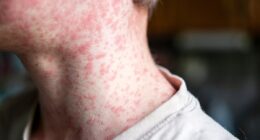
Fatty liver disease – also known as non-alcoholic fatty liver disease – applies to a range of liver conditions that are not caused by alcohol. Often the cause of fatty liver disease is having too much fat stored in the liver. If not caught in its early stages it can lead to cirrhosis – liver scarring – and even liver failure.
There are some signs of the condition that seem more obvious than others.
As an example, many people are aware of the correlation between jaundice (yellowing of eyes and skin) with the liver.
While abdominal pain, including cramping, could point you in the direction of the organ.
But according to the Mayo Clinic, slurred speech could be an indication of fatty liver disease.
READ MORE: Heart attack: How often you go to the toilet daily signals risk of ‘future’ heart attack
More specifically it means you could have cirrhosis.
Cirrhosis is the fourth and final stage of fatty liver disease, which occurs after years of the organ being inflamed.
READ RELATED: Weekly obesity jab halves the risk of diabetes and can spark sufficient weight loss
As a result the liver shrinks and becomes scarred and lumpy.
The Mayo Clinic explains: “The main complication of non-alcoholic fatty liver disease and non-alcoholic steatohepatitis (an aggressive form of liver disease) is cirrhosis, which is late-stage scarring in the liver.
DON’T MISS
Therefore, to reduce your risk of the disease the clinic advises the following.
Choose a healthy diet – Choose a healthy plant-based diet that’s rich in fruits, vegetables, whole grains and healthy fats.
Maintain a healthy weight – If you are overweight or obese, reduce the number of calories you eat each day and get more exercise. If you have a healthy weight, work to maintain it by choosing a healthy diet and exercising.
Exercise – Exercise most days of the week. Get an OK from your doctor first if you haven’t been exercising regularly.
Source: Daily Express









